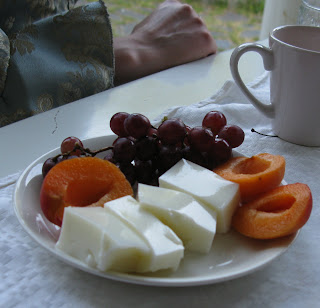Rosewater is not a staple spice in traditional (or even in the contemporary, more cross-culinary) Finnish cooking; therefore it took me a long while to realise it had such a wide range of uses. In this country, liquids that smell of rose are usually reserved for cosmetic purposes, which is a shame.
As I happen to have a bottle of rosewater in my fridge, I've been looking for new foods to put it in. Yesterday I came across a mention of medieval rosewater wafers, which were enjoyed at most festive occasions. Because of the wonders of the internet, I was able to find a recipe (here) and with some alterations, came up with the beauties pictured above. The main difference was that I didn't use a wafer iron, but a frying pan - just like when making contemporary pancakes.
My love affair with rose water officially began about a year ago, when Otter and I got the wonderful idea of trying out milk jelly according to an authentic Tudor recipe (as documented here). Although the gentle aroma of the slippery cubes didn't appeal to everyone, at least they were unlike anything we'd ever tasted before. Thus they were served as "second dessert" at our Renaissance party, along with lovely fruit and some anachronistic coffee, and if not universally adored, at least got sampled by all of our brave guests.
(The photo above courtesy of this guy who unfortunately isn't a fan of the white wobbly stuff.)
The preparations for next summer's period frock party have already begun, and one manifestation thereof can be seen above. Those are Rout Drop Cakes, the recipe for which I found in The Jane Austen Cookbook (by Maggie Black and Deirdre le Faye). Otter and I tried them out over the Easter holidays - and they were delicious, simply melting in the mouth. There's plenty of rosewater in them, but also some brandy, orange juice, currants and lots of sugar.
It says in the book that these little cakes "are pleasant with a glass of wine or a cup of coffee." Having tried them with both, I can assure that they are indeed.






